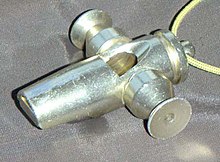Apito
Apito , also known as the samba pipe in German , is a three-tone pipe that is used in Brazilian samba music as a signaling instrument to mark the rhythm.
Function and use
In principle, the Apito works like an ordinary whistle , but has two holes that can be opened or closed individually or in combination to produce different tones.
In the original Brazilian samba, the samba whistle is usually played by the leader / conductor of the group and serves there practically exclusively as a signal generator to announce and mark breaks . In Europe it is also used as a rhythm instrument; This is often not done by the leader, but sometimes by a "normal" player in the samba group.
With a little practice, samba rhythms can also be played on a "normal" monotonous whistle. Therefore, some samba groups or musicians also use normal whistles as an alternative to the Apito, which are then also commonly referred to as samba whistles.
The samba pipe is also popular as a complement to maracas . However, there is a risk that it will sound too “artificial” and drown out the rattling. For this combination, a maracas model that is as loud as possible is required, which is roughly the same volume level as the whistle.
It is also easy to learn for children and is therefore also suitable as a toy instrument .
See also
Individual evidence
- ↑ Mário D. Frungillo: Dictionnaire de Percussão . Verlag Unesp, 2002, ISBN 8571394482 , p. 13 ( on Google Books )
